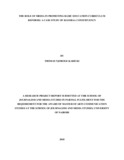| dc.description.abstract | This study examined the role of media in promoting basic education curriculum reforms in Kenya. The objectives of this study were to investigate the role of media in promoting basic education curriculum reforms, to examine the effectiveness of media messages on basic education curriculum reforms and to find out the level of media involvement of key stakeholders and audiences in Kenya. The research was carried out in Kiambaa constituency of Kiambu County. Two theories, namely, the Diffusion of Innovation theory and the Social Learning theory were utilised in the study. The study employed the mixed method approach where structured questionnaires and in-depth interviews were used as data collection methods. The method of proportional allocation was used to determine the sample size of 76 respondents. The study captured qualitative and quantitative data from the field which was analysed and presented in charts using the descriptive statistics. Findings from the field indicated that the senders and receivers of the curriculum reformation messages relied on media for information dissemination and influence. However, according to the respondents’, media was undependable because their content was based on a commercial perspective driven by specific customer interests. Key stakeholders like the Curriculum Support Officer, the headteachers and the teachers relied on ministry circulars for information. The study also found that there was minimal or no public participation before, during and after implementation of the new curriculum. This study recommends that the Education Ministry should set, maintain and occasionally evaluate public views by taking charge of the messages the media is disseminating. Country-wide civic education should also be done to create strategic alliances that support the curriculum reform agenda.The Education Ministry should also employ a county-based-management communication system to ensure that public participation included information exchange, public consultation and engagement, shared decisions, and shared jurisdiction. | en_US |



